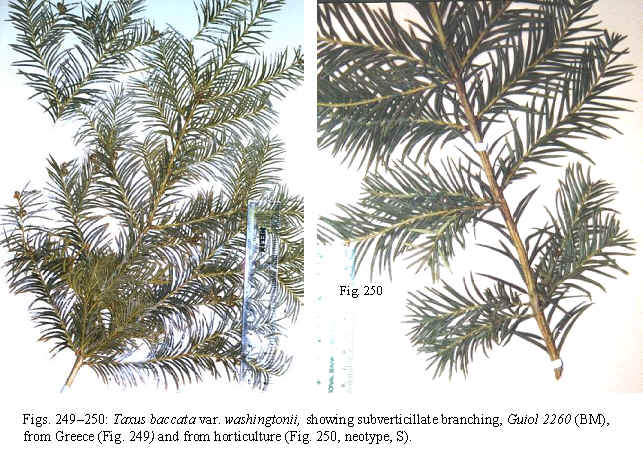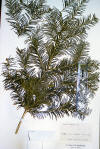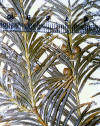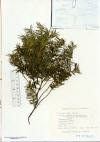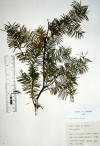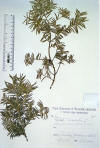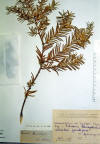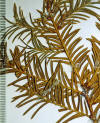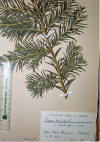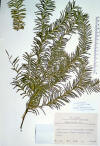|
1h. Taxus baccata var. washingtonii (hort. ex Richard Smith) Beissner (Figs. 82, 249–250), Ziergeh. ed. 2, 497. 1884. Taxus canadensis washingtonii R. Smith, 43. 1874. Taxus canadensis (var.) washingtonii Gordon, Pinetum ed. 2, 394. 1875. Taxus baccata var. washingtoniana Rehder in Bailey, Cyclopedia Amer. Hort. 1772. 1902.. Taxus baccata [f.] washingtoni Hort. ex Beissner, Hand. Nadelh. 175. 1891. Taxus baccata f. washingtonii Pilger, Pflanzenreich 18 (iv, 5): 114 1903. Developed in horticulture in the United States. Original herbarium material and origin of material unknown. Neotype Proposed—Horticulture: Hort. ex Bot. Berjianus, Stockholm—22 Oct.1927 at S! (det. by Florin, “Taxus baccata f. washingtonii”). Pectinate yew. Distribution: Europe, SW Asia (Syria, Turkey). Branchlets often long, pendulous, dichotomously divided, or with equal dichotomous divisions subpinnately arranged along a branch, yellowish-green, reddish orange with age; persistent bud-scales dark reddish brown, ca. 1 mm long, spreading with age. Leaves persistent on older twigs, not markedly discolored upon drying, sometimes yellowish below, mostly two-ranked to apex, linear, recurved and twisted, falcate, on horizontal branches with the uppermost overlapping the branchlet at leaf base, 1–2 cm long, 1–2 mm wide, 150–350 µm thick, pale green and convex above to a rounded midrib that forms a channel along the base of the midrib, pale yellowish green and concave below to a rounded midrib, abruptly revolute near margins 30–90°, more so at upper one-third of leaf; upper (adaxial) epidermal cells in transverse section elliptical, 10–15 µm tall, 25–40 µm wide; lower nonstomata epidermal cells smaller in diam., 8–12 µm tall, 10–20 µm wide, numbering (6-) 11–20 between margin and stomata band, mostly long rectangular, or incrassate near the stomata band, 3–7× l/w except short rectangular in 1–3 rows near margins, papillose across ˝ -ľ of the marginal zone, smooth on 3–8 (-10) rows of cells nearest the margins, usually with obscure papillae on midrib in 1–2 opposite or alternate rows on each cell; stomata bands broader than the marginal region with (6-) 7–10 (-11) stomata rows/band. Male bud cones globose ca. 1 mm diam., maturing near apex of branchlets. Seed near apex of 1st yr or 2nd branchlets, ovoid to subcylindric, 4 mm long, 2–4 mm diam., tan to brownish. Pectinate yew (var. washingtonii) is generally recognized by the yellowish green branchlets with strongly falcate leaves in which the uppermost leaves overlap branchlets near the base of the blade (when pressed), and by the leaves tapering to a sharply acute apex. The leaves spreading in the same plane as branchlets are indicative of plants with horizontal branching as originally described for this variety. Taxus baccata var. washingtonii is further recognized by the slender branchlets with narrow linear leaves that are relatively thin and revolute along margins when dried, but there are four other taxa that have these features. They may be differentiated as follows. (1) Taxus recurvata var. linearis has reddish orange to purplish pendulous branchlets in which the leaves twist with their adaxial surface facing the branch; it also differs by the leaves appearing more abruptly recurved near margins, and tapering to an obtuse apex that is often bent downwards. (2) Taxus canadensis var. minor—has darker green colored leaves lacking papillae along the abaxial midrib and most of the marginal zone. (3) A third is T. biternata—an E Asian species that differs by the reddish orange branchlets with sharply reflexed leaves near the petiole, in contrast to the arcuate leaves of var. washingtonii, and finally, (4) T. baccata var. elegantissima is distinguished by the slender leaves in hair like tufts on new growth (near apex of branchlets. The pectinate yew reportedly originated in the United States as a cultivar (variety) of T. canadensis (Gordon 1875). This report, which lacks supportive documentation, may have been deduced from a comparison with American species in character features of low habit and narrow leaves, while its transfer to T. baccata may be related to introduction into European horticulture where most cultivars have been traditionally treated under T. baccata. Nevertheless, relationships to T. canadensis are supported by leaves lacking papillae across 8 marginal cells (type) and by having fewer stomata rows as seen in a specimen from Turkey (Davis & Hedge 32208, 7 stomata rows/band, small epidermal papillae, and no papillae across 6 of 8 marginal cells), and by seed maturing on 2nd yr branchlets as evident in specimens from Czech Republic and Bosnia. However, this variety is placed under T. baccata based on phytogeographical data of leaf anatomical features. The type specimen, which is from horticulture, and which has strongly arcuate leaves that overlap the branchlets at the base of the blade when pressed, is remarkably similar to a specimen collected from the wild on Mt. Olympus, Greece (Figs. 246–247). The features that characterize Taxus baccata var. washingtonii appear intermediate between T. canadensis and other species that involve not only T. baccata, but also T. contorta, T. recurvata, and T. biternata. Indeed the specimens cited below may be from plants that resulted from former introgression with all of these species. For example, the type species for var. washingtonii, although similar to a specimen on Mt. Olympus, is also clearly related to specimens of T. recurvata in the United Kingdom as seen by the densely leafy whorled branches and recurved leaves. Moreover, T. recurvata itself is seen as a product of a long period of introgression between T. contorta and T. recurvata with the more densely branched and leafy specimens in the United Kingdom that intergrade into less densely branched and more distantly arranged leaves in specimens from Southwest Asia and eastern Europe. Specimens from Turkey and Transcaucasia exhibit branching, leaf spread, and leaf anatomical features (epidermal and parenchyma cells) that are similar to T. biternata or T. contorta, while other specimens from eastern Europe are difficult to separate from T. canadensis. Representative Specimens—Hungary: Schönach 3084 (S: C-2061, p.p.; US); Comit. Boraod. Ohassa, 550 m, Boros (BM); cult., 'overeynderi', ex Herb. Mus. Hist. Nat. Hung. Budapest, 11421 (US). ). Greece: Mt. Olympus, Guiol 2260 (BM). Bosnia: Mt. Plasma near Jablanica, 1500 m Biol. Inst. Dubrovnik 136 (NA). Czech Republic: Petrak, Fl. Bohemiae & Moravia. exsic. 99 (BM). Turkey: Old tree between Mollaveyis & Meydan, 20 km S of Ardesen below Camlihemsin, 750 m, Murray 936 (NA); Coruh (Artviaja), Tupa above Murgul, 1400 M Davis & Hedge 32208 (BM). Transcaucasia Caucasus Mountains: Ex Herb. Inst. Bot. Ac. Sc. URSS (US: 2560106) |
|||
|
Greece: Mt. Olympus, Guiol 2260 (BM) Illustration indicates leaf lacks papillae on abaxial epidermal surface across 4 marginal cells. This is followed by 10 rows of papillose cells, then a stomata band with 7 rows of stomata on one side of the midrib, 8 rows on the other side, and a midrib of 18 cells across. Midrib papillae appear rather low and obscure, most prominent on outer rows of cells. Note the pointed seeds. |
Bosnia: Mt. Plasma near Jablanica, 1500 m Biol. Inst. Dubrovnik 136 (NA). Illustration indicates leaf lacks papillae on abaxial epidermal surface across 2–-4 marginal cells. This is followed by no papillose cells; however, a second leaf examined with a separate drawing attached to packet did indicate 4 rows of papillose cells. This is followed by a stomata band with 6 rows of stomata on one side of the midrib, 7 rows on the other side, and a papillose midrib of 18 cells across. The parenchyma cells in the spongy mesophyll were indicated to be reddish in color. Note the apical rounded seed. The illustration attached to the specimen also indicates leaf epidermal cells as seen in x-section average ~18 µm tall and 25 µm wide and that the entire leaf was 250 µm thick, and that stomata were in 7 rows. |
Turkey: Tupa above Murgul, 1400 M Davis & Hedge 32208 (BM). Illustration indicates leaf lacks papillae on abaxial epidermal surface across 6 marginal cells. This is followed by no papillose cells, then a stomata band with 7 regular rows of stomata and a yellowish midrib that is smooth (lacks papillae). The color of the leaf was noted under the microscope to be very similar to T. canadensis. Additional Note: Branching, leaf shape, and leaf epidermal features are very similar to T. biternata, which differs the reddish-orange color on branchlets and leaves spreading more abruptly near petiole. |
Czech Republic: Petrak, Fl. Bohemiae & Moravia. exsic. 99 (BM). Illustration indicates leaf lacks papillae on abaxial epidermal surface across 4–5 marginal cells. This is followed 5 rows of papillose cells, then a stomata band with 8 rows of stomata and a greenish midrib that is smooth (lacks papillae). The color of the leaf is shown to be green as seen under the microscope. Additional Note: Mature seed cone on 2nd yr branchlet is also characteristic of T. canadensis, in contrast to T. biternata in which its seeds are seen on 1st yr branchlets. |
|
Caucasus Mountains: Ex Herb. Inst. Bot. Ac. Sc. URSS (US: 2560106) Illustration indicates leaf lacks papillae on abaxial epidermal surface across 4 marginal cells. This is followed by 10 rows of papillose cells, then a stomata band with 9 rows of stomata on one side of the midrib, and a midrib of 15 cells across with papillae on the outer 4 rows of cells. Note the short prismatic seeds on 1st yr branchlets.
|
Hort. ex Bot. Berjianus, Stockholm—22 Oct.1927 (S) Illustration indicates leaf lacks papillae on abaxial epidermal surface across 8 marginal cells, 3 of the rows nearest margin are noted be smaller. This is followed by 8 rows of papillose cells, then a stomata band with 10 rows of stomata, and a midrib of 12 cells across with obscure papillae. Note the rounded leaf margins as seen in x-section. This compares to T. contorta. The specimen was reportedly taken from a garden plant, which may be a hybrid between T. recurvata and T. canadensis (European form). |
Illustration indicates leaf lacks papillae on abaxial epidermal surface across 5 marginal cells. This is followed by 11 rows of papillose cells, then a stomata band with 9 rows of stomata, and a papillose midrib. Note the round leaf margins as seen in x-section. This compares to T. baccata or T. contorta. . |
Cultivated: Quebec, Montreal. Bailleul, 1586-1978 (MTJB). |
